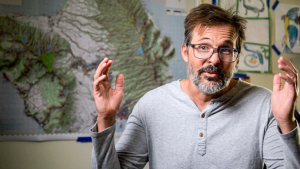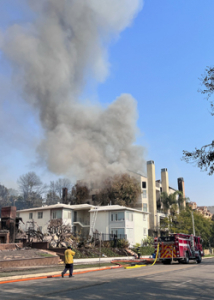
Wildfires have left devastating impacts in recent years, including catastrophic events in California and Hawaiʻi. As these fires become more frequent and severe, understanding their causes, spread and prevention is essential. UH News interviewed wildfire expert Clay Trauernicht, researcher at the University of Hawaiʻi at Mānoa College of Tropical Agriculture and Human Resilience, to explore the factors driving wildfires, the role of ecosystems, and the important lessons that can be learned from these disasters.
What are the primary factors that determine the spread of wildfires?

So as far as fire starting and fire occurrence, it really boils down to three factors. Climate and weather is a big one, so you need hot, dry and windy conditions. You need an ignition source, you need something to spark the fire, and pretty much around the world, the vast majority of fires are started by people. Otherwise, lightning is a common source of ignition, in Hawaiʻi we get lava ignited fires, for example, and you need fuels. So fuels in the fire science lingo is pretty much vegetation, anything that’s out there to burn, and unfortunately when we see, these sort of wildland urban interface fires like we’re seeing in California like we saw in Lahaina, sometimes the fuel is homes themselves.
The other difficulty is this interface—the wildland urban interface is where homes lie adjacent to these burnable fuels in the landscape, and we’re sort of seeing the worst possible place to have homes and to have a fire start. So similar to Lahaina, once you get an ignition that’s burning through vegetation, once it jumps into homes and it’s under these kinds of conditions, it’s extremely difficult, extremely dangerous to try any kind of suppression effort. You’re pretty much evacuating in that instance.
How are ecosystems impacting the wildfires in California?

I think the hard truth to face as far as Southern California is concerned is that you’re building into an environment that is evolutionarily designed to burn and burn hot, and it’s happened again and again.
To say that this was a surprise would be a lie because we know the ecosystems around LA are adapted to burn. They’re the chaparral ecosystem, the plants there need fire to survive, to regenerate. And there’s a long history of not only fires in that ecosystem but actually fires taking out homes, like crossing that line into the communities and destroying homes. And so the problem there again in recent history is the building of homes into this fire prone environment.
Can you discuss the similarities and differences between the fires in California to what happened in Lahaina?
In both cases, the real core of the problem is human decision making. Climate change is going to make them harder to deal with, but the root cause of fire and fire loss both in Lahaina and in Southern California are really societal decisions. Where are we building and why? What are we doing with the land and why? How does that confer risk to our loved ones, our communities and things that we value?
In Hawaiʻi, we have to kind of flip this because homes and communities have been in these places for many years, but it’s only been in the past 20–30 years that fire risk has become really pronounced. That’s because based on development and land use policies, we are not compelling landowners, especially on former plantation lands, to do something different on those lands. So in the interest of public safety, you cannot just leave these abandoned and let them go fallow and just have all of these haole koa and buffel grass and guinea grass growing uncontrolled. And so the questions become: how do you prioritize public safety, what kind of policies do you implement? I think in both places it comes back to land use and regulations.

